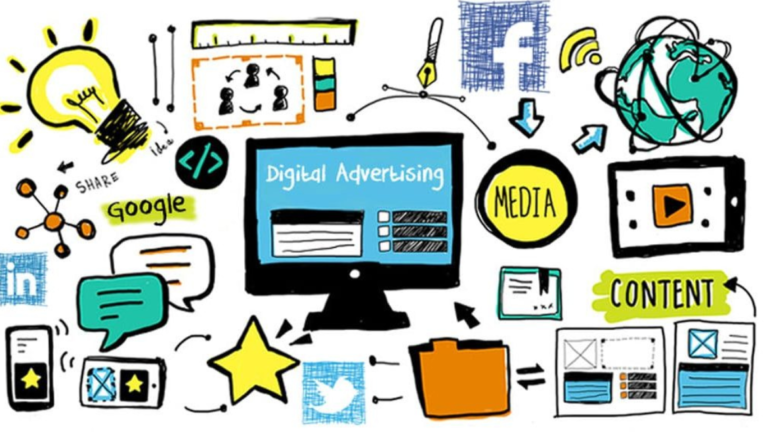Captivating clients is a time-honored skill. This medium is what’s new. Digital marketing has grown in popularity as a result of technological advancements and the globalization of trade. This form of advertising aims to attract customers through various online mediums. For a while now, this sector of the economy has been expanding at a tremendous rate. Aspiring digital marketers can gain the skills necessary for future success by understanding the history of the field.
Digital Marketing: A Quick Overview
The foundation for a contemporary and enormous digital audience was laid by a series of technical advances around the beginning of the 2000s, according to the Digital Marketing Agency Institute. Most people agree that the internet, big data, and cellphones are the most consequential of these.
The Wide Web
The idea of the internet has been around since the 1960s, but it wasn’t until 1989 that scientist Tim Berners-Lee actually created the World Wide Web. At his previous employer, the Conseil Européen pour la Recherche Nucléaire (CERN), he had the primary objective of establishing connections between computer networks. The initial invitations to join were extended to individuals from outside the organization in 1991. Netscape was launched in 1994 and was the first mass-market browser to achieve success. There was a surge from sixteen million to seventy million internet users in the two years following Netscape’s public debut.
The digital landscape underwent a transformation due to the exponential increase in internet users. Email, Google and Yahoo!’s advanced search capabilities, and the rise of e-commerce platforms like Amazon and eBay opened up new channels for businesses to communicate with customers. Search engines allowed consumers to locate products, and email became a marketing tool. Also introduced were the first search engine optimization strategies, such as keyword stuffing, over-tagging, and backlinking.
“Big Data”
Modern methods of capturing and storing data have advanced in tandem with the rise of digital activities. The ability to record, store, and analyze online consumer activity had now been realized. Businesses found this to be very helpful since it revealed information about their customers and how to communicate with them. Big data expanded with the popularity of social media sites like LinkedIn, MySpace, Facebook, and Twitter, where users shared an ever-increasing amount of personal information.
In the end, businesses were able to use big data to monitor consumer habits, target their ads more precisely, and provide predictive analytics. Because of this, they were able to establish deeper, more meaningful relationships with their clients than before.
Mobile devices
The earliest mobile phones didn’t appear until the 1970s, and they kept getting better all the way into the new millennium and beyond. Nonetheless, the BlackBerry is thought of as the pioneering effort in smartphone technology. After its 2003 release, businesses and governments began to favor the device due to the security of its network and the fact that it enabled users to send and receive emails through their devices.
The iPhone was introduced by Apple in 2007. Marketers could now contact customers more precisely, directly, and for longer durations thanks to this innovation, which ushered in the real smartphone era. The subsequent explosion in smartphone use drove social media usage even higher, which in turn opened up even more opportunities for marketers. In 2011, the average amount of time Americans spent engaging with mobile media was 46 minutes. This figure was 258 in 2017. In terms of digital devices used to access the internet, smartphones have recently surpassed all others in the US.
The Role of Digital Marketing in the Modern World
- The accessibility of a large digital audience today is a driving force in digital marketing. As per studies conducted by Smart Insights:
- As of 2018, more than 4 billion people across the globe are using the internet.
- Roughly 3.2 billion people across the globe use some form of social media.
- As of 2018, there are approximately 5.14 billion people using mobile phones around the globe.
- These figures clearly show an increase in usage compared to prior years.
- Moreover, the following tendencies impact the state of digital marketing today:
Customer Actions
Even before a buyer contacts sales, 70% of their journey is already finished.
The proliferation of personal information sharing has been accelerated by the rise of digital media. This suggests that millennials and Gen Zers, who grew up with the internet, place a premium on customization when shopping online.
Media Used to Communicate with Clients
Nowadays, people prefer using their mobile phones to access the internet, followed by desktop computers.
Research shows that millennials use three different types of screens on a daily basis. Contrarily, there are five devices that members of Generation Z use: cellphones, televisions, computers, desktops, and portable media players like iPods or iPads.
Project Categories
Agile marketing in the digital realm is now relied upon by more and more companies. The effectiveness of an organization’s marketing efforts can be evaluated using agile marketing metrics. The emphasis is on getting new projects up and running quickly so that you can take advantage of ad opportunities as they arise.
Nowadays, marketing is more about uncovering and disseminating facts than it is about making up stories and selling them. Customers are able to research and compare products with greater ease, which is causing this.
Due to advancements in SEO, tactics such as spamming with backlinks and stuffing keywords are now ineffective. Nowadays, valuable content takes their place.
Traditional, time-tested forms of advertising continue to yield respectable results, even in the face of the meteoric climb of digital marketing. Print ads, TV commercials, and radio spots are still mainstays of most agencies’ marketing campaigns.
When taken as a whole, these facts illustrate the dynamic nature of today’s digital landscape, where instantaneous access to high-quality content across several digital platforms is highly valued by customers.
Digital Marketing’s Long-Term Prospects
It is logical to anticipate that digital marketing will also evolve in tandem with the expansion and improvement of technology. We can foretell the industry’s potential future directions based on our understanding of the current market. Some short-term trends are predicted by Forbes
Integrated global marketing has been given more priority. By using this strategy, readers are able to draw connections between seemingly unrelated pieces of content, such as an email and a blog post, that cover various aspects of the same subject.
Utilization of integrated marketing technology platforms. A more uniform and unified integration of technologies is on the horizon for digital marketing.
An “omnichannel marketing strategy” refers to a company’s increased usage of data mining and deep analytics with the goal of maximizing coordinated exposure across all digital channels.
The emphasis on account-based marketing will be magnified.
Adobe has also identified the following trends, according to CMO.com:
A steady, sluggish increase in the total number of people using the Internet
The ever-increasing popularity of watching videos online
For the foreseeable future, the majority of consumer Internet data traffic will come from audio and video sources.
Digital marketing agencies of the future will need employees who are prepared to take on these new challenges and maintain their positions as industry leaders if they want to be successful.
Promising Career Paths for the Next Generation of Digital Marketers
A professional’s role also needs to adapt to the ever-shifting digital landscape. The marketers of the future need to have the skills and education to fill a wide variety of positions in the industry. Here are a few:
- Director of artistic production
- Copywriter
- Supervisor of social media
- Media relations specialist
- Analyst for research
- Manager of advertising accounts
- Manager of public relations
- Media buyer
Planned accounts management
The University of West Alabama offers a bachelor’s degree program in integrated marketing communications online, which is a great way to get a head start on your career. Our online Bachelor of Arts/Bachelor of Science degree in Integrated Marketing Communications offers a wide range of electives, including but not limited to: sports communication, graphic design, and integrated marketing communications. Those interested in advancing their marketing careers can also enroll in our Master of Arts program in integrated marketing communication. At one of the state’s most reasonably priced universities, you can complete your degree entirely online.

